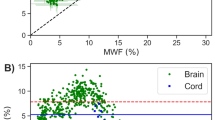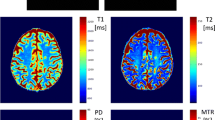Abstract
Multi-echo T2 measurements are invaluable in studying brain pathology in multiple sclerosis (MS). In addition to information about myelin water and total water content, the T2 distribution has the potential to detect additional water reservoirs arising from other sources such as inflammation or edema. The purpose of this study was to better define the T2 distribution in MS lesions and normal appearing white matter (NAWM) with particular emphasis on the characterisation of longer T2 components.Magnetisation transfer (MT), T1 and 48-echo T2 relaxation data were acquired in 20 MS subjects and regions of interest were drawn in lesions and NAWM. Twenty-seven out of 107 lesions exhibited signal with a markedly prolonged T2 (200–800 ms). Lesions with a Long-T2 signal also exhibited a longer geometric mean T2 (GMT2), increased water content (WC), higher T1, reduced magnetisation transfer ratio (MTR) and decreased myelin water fraction (MWF) than lesions without a Long-T2 signal. Those subjects with Long-T2 lesions had a significantly longer disease duration than subjects without this lesion subtype. A strong correlation was observed between T1 and Long-T2 fraction, while a slightly weaker relationship was found for GMT2, MTR and MWF with Long-T2 fraction. A potential source of the Long-T2 signal is an increase in extracellular water. This study supports the usefulness of increasing the data acquisition window of the multi-echo T2 relaxation sequence to better characterise the T2 decay in MS.
Similar content being viewed by others
References
Armspach JP, Gounot D, Rumbach L, Chambron J (1991) In vivo determination of multiexponential T2 relaxation in the brain of patients with multiple sclerosis. Magn Reson Imaging 9:107–113
Barnes D, McDonald WI, Johnson G, Tofts PS, Landon DN (1987) Quantitative nuclear magnetic resonance imaging: characterisation of experimental cerebral oedema. J Neurology, Neurosurgery and Psychiatry 50:125–133
Fatouros PP, Marmarou A (1999) Use of magnetic resonance imaging for in vivo measurements of water content in human brain: method and normal values. J Neurosurgery 90:109–115
Fenrich FR, Beaulieu C, Allen PS (2001) Relaxation times and microstructures. NMR Biomed 14:133–139
Flynn SW, Lang DJ, Mackay AL, Goghari V, Vavasour IM, Whittall KP, Smith GN, Arango V, Mann JJ, Dwork AJ, Falkai P, Honer WG (2003) Abnormalities of myelination in schizophrenia detected in vivo with MRI, and post-mortem with analysis of oligodendrocyte proteins. Molecular Psychiatry 8:811–820
Helms G (2001) Volume correction for edema in single-volume proton MR spectroscopy of contrast-enhancing multiple sclerosis lesions. Magnetic Resonance in Medicine 46:256–263
Kamman RL, Go KG, Brouwer W, Berendsen HJ (1988) Nuclear magnetic resonance relaxation in experimental brain edema: effects of water concentration, protein concentration, and temperature. Magn Reson Med 6:265–274
Larsson HB, Frederiksen J, Petersen J, Nordenbo A, Zeeberg I, Henriksen O, Olesen J (1989) Assessment of demyelination, edema, and gliosis by in vivo determination of T1 and T2 in the brain of patients with acute attack of multiple sclerosis. Magn Reson Med 11:337–348
Laule C, Vavasour IM, Moore GRW, Oger J, Li DKB, Paty DW, MacKay AL (2004) Water content and myelin water fraction in multiple sclerosis: A T2 relaxation study. J Neurol 251:284–293
Laule C, Whittall KP, MacKay AL (2001) Shortening the acquisition time of a 48 echo T2 relaxation pulse sequence by varying TR across k-space. In: 9th Annual Meeting of the International Society for Magnetic Resonance in Medicine. Glasgow, Scotland, p 896
Lawson CL, Hanson RJ (1974) Solving Least Squares Problems. Prentice-Hall, Englewood Cliffs, NJ
MacKay A, Whittall K, Adler J, Li D, Paty D, Graeb D (1994) In vivo visualization of myelin water in brain by magnetic resonance. Magn Reson Med 31:673–677
Oh J, Han ET, Pelletier D, Nelson SJ (2006) Measurement of in vivo multicomponent T2 relaxation times for brain tissue using multi-slice T2 prep at 1.5 and 3 T Magn Reson Imaging 24:33–43
Rumbach L, Armspach JP, Gounot D, Namer IJ, Chambron J, Warter JM, Collard M (1991) Nuclear magnetic resonance T2 relaxation times in multiple sclerosis. J Neurol Sci 104:176–181
Skinner M, Whittall KP, MacKay AL (2001) Effect of Variable Echo Spacing in Multi-Echo Sequences for Resolving Long T2 Components in Multiple Sclerosis. In: International Society for Magnetic Resonance in Medicine. Glasgow, Scotland, p 904
Tofts PS (ed) (2003) Quantitative MRI of the brain: measuring changes caused by disease. Wiley, Chichester, West Sussex, Hoboken, NJ
Tozer DJ, Davies GR, Altmann DR, Miller DH, Tofts PS (2005) Correlation of apparent myelin measures obtained in multiple sclerosis patients and controls from magnetisation transfer and multicompartmental T2 analysis. Magn Reson Med 53:1415–1422
Vavasour IM (1998) Magnetic resonance of human and bovine brain. In: Physics.University of British Columbia, Vancouver, p 120
Vidarsson L, Conolly SM, Lim KO, Gold GE, Pauly JM (2005) Echo time optimization for linear combination myelin imaging. Magn Reson Med 53:398–407
Whittall KP, MacKay AL (1989) Quantitative interpretation of nmr relaxation data. Mag Reson 84:64–71
Whittall KP, MacKay AL, Graeb DA, Nugent RA, Li DK, Paty DW (1997) In vivo measurement of T2 distributions and water contents in normal human brain. Magn Reson Med 37:34–43
Whittall KP, MacKay AL, Li DK, Vavasour IM, Jones CK, Paty DW (2002) Normal-appearing white matter in multiple sclerosis has heterogeneous, diffusely prolonged T(2). Magn Reson Med 47:403–408
Wu Y, Alexander AL, Fleming JO, Duncan ID, Field AS (2006) Myelin water fraction in human cervical spinal cord in vivo. J Comput Assist Tomogr 30:304–306
Author information
Authors and Affiliations
Corresponding author
Rights and permissions
About this article
Cite this article
Laule, C., Vavasour, I.M., Kolind, S.H. et al. Long T2 water in multiple sclerosis: What else can we learn from multi-echo T2 relaxation?. J Neurol 254, 1579–1587 (2007). https://doi.org/10.1007/s00415-007-0595-7
Received:
Revised:
Accepted:
Published:
Issue Date:
DOI: https://doi.org/10.1007/s00415-007-0595-7




